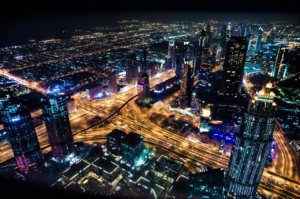A Washington Post article by Annys Shin [“The City as Modern Muse,” 18 Sep 2006] discusses the theories being promoted by a George Mason University professor named Richard Florida about how to make cities more resilient. Florida “argues that cities that attract highly educated ‘creative class’ workers fare better economically” than those that do not. Shin’s article follows Florida as he tours some of the communities in and around the Washington, DC. One of those communities, Hyattsville, is an inner beltway city trying to transform its image. Shin reports:
Stepping onto the sidewalk, Florida surveyed a series of billboards advertising town homes starting in the $300,000s. The signs depicted a tidy, middle-class community scheduled to take the place of empty lots. Local officials envision a potpourri of artists and families and professionals inhabiting a vibrant new neighborhood. Florida wondered. “It looks like an attempt to recreate an urban fabric,” he said. But, “can you really build something new that has those organic neighborhood qualities? That’s a big open question.”
“People don’t want to live in something prefab, especially since we’ve all left family behind,” he said later. “We want to go somewhere real, to be part of something bigger than us. Value comes from authentic-ness.”
This is a real question for the development community as it looks to help failed states emerge from poverty. How do you preserve (even stimulate) local culture while simultaneously helping to create the critical infrastructure necessary to attract foreign direct investment, create jobs, and improve the quality of life for all citizens? Florida doesn’t appear sure. His hesitance probably arises from the fact that in Hyattsville it appears that politicians and developers may not have involved the local community as fully as it should have been as they generated their plans. Those whose lives will change the most must be intimately involved as plans are made. In order to preserve the “authentic-ness” that Florida lauds, local citizens must not only embrace such plans but feel they had a role in drafting them and, thus, have a stake in their success. As the article continues, Florida returns to his favorite subject, attracting a “creative class” into the heart of the city.
Creative-class types, after all, value authenticity. They prefer “streets lined with a multitude of small venues” such as coffee shops, restaurants and bars with live performances and exhibits, art galleries and bookstores, which set the stage for overlapping social scenes, Florida writes in “The Rise of the Creative Class.” For members of the creative class, “this kind of ‘scene of scenes’ provides another set of visual and aural cues they look for in a place to live and work,” he writes. “You may not paint, write or play music, yet if you are at an art-show opening or in a nightspot where you can mingle and talk with artists and aficionados, you might be more creatively stimulated than if you merely walked into a museum or concert hall, were handed a program, and proceeded to spectate.” “I believe people are creative. Creative people are not just knowledge workers,” he said.
One of the challenges that military and development personnel have faced in the aftermath of crises in failed states is developing proper measures of effectiveness. How do you know you are succeeding? They have used measures like how many markets reopen, how many soccer fields are busy on weekends, and so forth. Another measure might be how many creative people are successfully working in urban areas.
Another Washington Post article by Sudarsan Raghavan [“Violence Changes Fortunes of Storied Baghdad Street,” 18 Sep 2006], appears to support this theory. It talks about Mutanabi Street, famed as Iraq’s center of literature and thought. For centuries Mutanabi Street has been “the intellectual ground zero of Baghdad, [its shopowners] the guardians of a literary tradition that has survived empire and colonialism, monarchy and dictatorship.” Today, the street sits silent; customers having been driven away by violence. It will be an area to watch to see if the challenges in Baghdad are being successfully met.
Returning to Florida’s arguments, he notes that openness and tolerance are among the qualities that help define a resilient city. He also notes other qualities:
Like other creative-class centers, Washington is already facing threats to the vital mix, he said: a dearth of affordable housing and rising income inequality. The very dynamics that are attracting creative-class workers to the area are also helping drive out the qualities they seek. And that, in turn, can lead to stifling homogeneity — a creativity killer.
For those concerned that globalization is a culture killer, Florida’s theories should be comforting. He is basically claiming that resiliency comes from fostering culture not destroying it. This is worth keeping in mind as philanthropists work with non-profit groups and businesses to help shrink the Gap.




